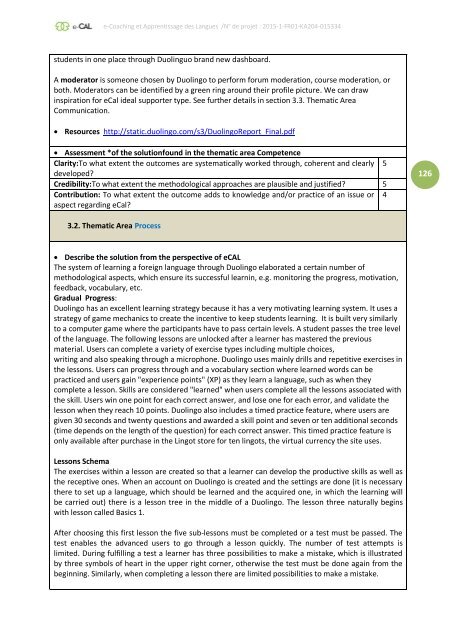e-CAL - e-Coaching et Apprentissage des Langues
The ERASMUS+ project e-CAL presents the result of an analysis of support methods in the case of language learning using web-based Open Educational Resources (OER).
The ERASMUS+ project e-CAL presents the result of an analysis of support methods in the case of language learning using web-based Open Educational Resources (OER).
You also want an ePaper? Increase the reach of your titles
YUMPU automatically turns print PDFs into web optimized ePapers that Google loves.
e-<strong>Coaching</strong> <strong>et</strong> <strong>Apprentissage</strong> <strong>des</strong> <strong>Langues</strong> /N° de proj<strong>et</strong> : 2015-1-FR01-KA204-015334<br />
students in one place through Duolinguo brand new dashboard.<br />
A moderator is someone chosen by Duolingo to perform forum moderation, course moderation, or<br />
both. Moderators can be identified by a green ring around their profile picture. We can draw<br />
inspiration for eCal ideal supporter type. See further d<strong>et</strong>ails in section 3.3. Thematic Area<br />
Communication.<br />
Resources http://static.duolingo.com/s3/DuolingoReport_Final.pdf<br />
Assessment *of the solutionfound in the thematic area Comp<strong>et</strong>ence<br />
Clarity:To what extent the outcomes are systematically worked through, coherent and clearly 5<br />
developed?<br />
Credibility:To what extent the m<strong>et</strong>hodological approaches are plausible and justified? 5<br />
Contribution: To what extent the outcome adds to knowledge and/or practice of an issue or 4<br />
aspect regarding eCal?<br />
126<br />
3.2. Thematic Area Process<br />
Describe the solution from the perspective of e<strong>CAL</strong><br />
The system of learning a foreign language through Duolingo elaborated a certain number of<br />
m<strong>et</strong>hodological aspects, which ensure its successful learnin, e.g. monitoring the progress, motivation,<br />
feedback, vocabulary, <strong>et</strong>c.<br />
Gradual Progress:<br />
Duolingo has an excellent learning strategy because it has a very motivating learning system. It uses a<br />
strategy of game mechanics to create the incentive to keep students learning. It is built very similarly<br />
to a computer game where the participants have to pass certain levels. A student passes the tree level<br />
of the language. The following lessons are unlocked after a learner has mastered the previous<br />
material. Users can compl<strong>et</strong>e a vari<strong>et</strong>y of exercise types including multiple choices,<br />
writing and also speaking through a microphone. Duolingo uses mainly drills and rep<strong>et</strong>itive exercises in<br />
the lessons. Users can progress through and a vocabulary section where learned words can be<br />
practiced and users gain "experience points" (XP) as they learn a language, such as when they<br />
compl<strong>et</strong>e a lesson. Skills are considered "learned" when users compl<strong>et</strong>e all the lessons associated with<br />
the skill. Users win one point for each correct answer, and lose one for each error, and validate the<br />
lesson when they reach 10 points. Duolingo also inclu<strong>des</strong> a timed practice feature, where users are<br />
given 30 seconds and twenty questions and awarded a skill point and seven or ten additional seconds<br />
(time depends on the length of the question) for each correct answer. This timed practice feature is<br />
only available after purchase in the Lingot store for ten lingots, the virtual currency the site uses.<br />
Lessons Schema<br />
The exercises within a lesson are created so that a learner can develop the productive skills as well as<br />
the receptive ones. When an account on Duolingo is created and the s<strong>et</strong>tings are done (it is necessary<br />
there to s<strong>et</strong> up a language, which should be learned and the acquired one, in which the learning will<br />
be carried out) there is a lesson tree in the middle of a Duolingo. The lesson three naturally begins<br />
with lesson called Basics 1.<br />
After choosing this first lesson the five sub-lessons must be compl<strong>et</strong>ed or a test must be passed. The<br />
test enables the advanced users to go through a lesson quickly. The number of test attempts is<br />
limited. During fulfilling a test a learner has three possibilities to make a mistake, which is illustrated<br />
by three symbols of heart in the upper right corner, otherwise the test must be done again from the<br />
beginning. Similarly, when compl<strong>et</strong>ing a lesson there are limited possibilities to make a mistake.


